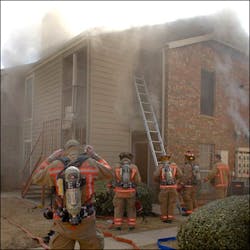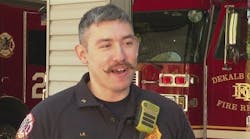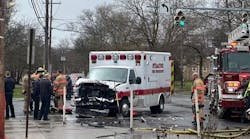The most experienced firefighter can have difficulty applying realistic approaches to rapid intervention methods, techniques and maneuvers especially if they haven't even pursued the training.
Well it has been a good 15 years since rapid intervention began its foothold in the fire service and my involvement with it has been an eye opening experience with unbelievable progress and innovations as well as setbacks and controversy.
What should we be seeing and doing in rapid intervention as it pertains to the firefighters, line officers and chief officers at fireground incidents? The following article will probably surprise some while others have known or have been aware of what true rapid intervention, combined with proactive and reactive behaviors are so "That Brothers May Live." And I do truly mean live.
The most experienced firefighter can have difficulty applying realistic approaches to rapid intervention methods, techniques and maneuvers especially if they haven't even pursued the training. Worse yet, if the department that didn't provide the means to get the training that not only saves lives but ensures an enhanced measure of safety on each and every fireground. Even worse then that is the firefighter that waits for the department to provide the means of training from the very start is his responsibility to attain for himself, his co-workers, his department and his family. Enough said!
Realistic and Appropriate
Let's really take a look at applying realistic and appropriate behaviors in rapid intervention in the training environment and on the fireground. Many individuals and departments talk a big game but are not truly a student of the game when it comes to rapid intervention. Rapid intervention has been interpreted, toyed with, chewed up and regurgitated into several approaches, methods, maneuvers and techniques by many individuals in the fire service. Some of those individuals are what we would call pretty prominent figures in the teaching and lecture world. Many of these respected and appreciated individuals are starting to lose sight of what are truly rapid interventions capabilities and its life saving expectations. Rapid intervention may very well be coming over theorized with inappropriate applications resulting in less than adequate results for the line firefighter all the way on up to the chief in training and on the fireground.
Here's what we need to know as the bottom line when it comes to rapid intervention:
- Training that is consistent but innovative in rapid intervention and self survival skills
- Provide training and understanding in air management skills
- Training that instills both proactive and reactive behavior during fireground incidents
- Innovative methodologies for teaching techniques and maneuvers that is clear and simple in order to be performed under extreme duress
- From the firefighter to the chief, know the purpose in basic rapid intervention tactics and strategies
- Develop simple but urgent operating guidelines
- Realize the simple and appropriate equipment required for rapid intervention
- Understand the tactical positioning and deployment of rapid intervention
- Give rapid intervention the freedom to function effectively on the fireground
These are some of the top priority items and philosophies in establishing and developing a continuous and sound rapid intervention program and operating guidelines for just about any size department. Through years of instructing in both combination and volunteer departments, I have found the needs and priorities of rapid intervention for each of these types of departments to be well intentioned but for some to them, they wherever difficult to achieve. In many cases it is extremely difficult for some departments to even muster two-person team dedicated to rapid intervention, let alone the more blessed departments that can dedicate four or five firefighters to a RIT. What can one department do and accomplish for rapid intervention that another department can't do in addressing the needs of rapid intervention? The answer is that each department needs to train, train and train according to their levels of realities.
Improving the Odds
It is more important that each firefighter and officer be trained as thoroughly as possible in self survival skills and rapid intervention to ensure and enhance their safety and possible needed rescue of a distressed firefighter. This is true on any fireground, no matter what the response size or personnel presence is. If members are adequately trained, we can provide better outcomes for the fallen firefighter as well as for the rescuers.
Often times when a mayday incident occurs, firefighters rush in to help the fallen member before a rapid intervention response, even with the presence of a dedicated RIT on scene. This is not a lack of discipline but the reality of human nature for the need to save others that has been imbedded in our make up as firefighters. It's simple: we react through commitment and training to the emergencies and we really react to emergencies when it is one of our own. Without self survival or rapid intervention skills our reaction would for sure turn into additional losses especially when we're right there when it occurs.
So you see rapid intervention is truly a rapid response in the hands of any amount of well trained individuals who know what to do. When the RIT arrives whether its seconds or minutes into a mayday, it just provides those reacting in the immediate area a guarantee for an improved chance with a plan of action and additional resources where there may be none. Regarding maydays, if there's one thing that will defeat or decrease are probabilities of success its chaos.
The idea behind a well-trained rapid intervention team and their actions are to:
- Acknowledge receiving their assignment as the RIT and announce their arrival at the scene through dispatch and command
- Bring the proper personnel and equipment to do the job: rope bag, air supply, irons, thermal imaging, webbing, lights and wire cutters. Get secondary equipment not in use from immediate vehicles in the fire area involved in the incident: saws, ladder, etc.
- Go to the sector involved in the offensive/defensive procedures, not to the command post. If you don't know where the sector involved in the offensive/defensive procedures is then report to the command post. At larger incidents (high-rise or commercial buildings or warehouse structures) report to a forward area. Check in with a sector officer. Announce your presence and sector position to command. If there is no sector established, establish it and inform command
- RIT to establish their presence as soon as possible at the proper sector of the structure involved. Preferably where the firefighters enter the structure. Where has the hoseline made entry? Where is the primary search being conducted? Are there firefighters on the second floor? In the basement? Where is the main body of fire? Where is the fire going? Who's in charge of whom?
- RIT's and their team leaders are to monitor all fireground radio communications and establish an additional radio channel for RIT communications if possible. This enables the proper tracking methods regarding movement and assignments as well as actions of firefighters within the interior and on the roof. Encircling the building also provides for visual movement and accountability of firefighters.
- RIT's no longer just stand around, they are physically and extremely proactive like ants on an ant hill. Collecting secondary equipment such as a power saw, ladders and even establishing a second or third hoseline lead out if none is present to protect firefighters as well as themselves when needed.
- When RIT's are in need of equipment they should go to the nearest engine or truck and confer with the operator and get it. Operators should be instructed through policy that if a RIT asks for something, they should give it up if it's still on your rig and not in use.
- Good RIT's are proactive and allowed to function in that capacity. Seeking approval to perform proactive behaviors is time consuming and occupies radio traffic. Instead advise sectors or command personnel of your actions. If it's closed up, open it up without affecting fire conditions. With operations on the second floor of any type, the RIT should raise ladders to windows, at least two on two sides the structure. RIT's are to provide more ways out of a structure for interior firefighters which also provides the RIT more ways in to get to a firefighter in distress
- RIT's should help out on hoseline advancements while insuring the integrity of the stretch (kinks, turns, doors etc)
- A RIT for the fireground should be like having a giant safety officer for incident command. The RIT should inform and update his sector or command on the firefight from improved conditions to worsening conditions that are or have gone unnoticed.
- RIT should continually monitor the possibilities of collapse and its warning signs. Every member of the team should have two sides of the structure in view at all times when not tasking.
- In the event of a mayday the RIT can help firefighters that are racing inside to remain focused on protecting the rescue effort as well.
The afore mentioned proactive behaviors are just a minor glimpse into the attitudes and adjustments firefighters and their departments should be moving towards regarding rapid intervention. It must be remembered that throughout many areas of the country rapid intervention can barely exceed the expectations of the "Two In/Two Out" standards required by OSHA and the NFPA. None the less departments should still be involved and train on all aspects of firefighter rescue and survival no matter what the response or manpower situation in providing Rapid Intervention.
Implementation and Training
Fire departments no matter what the size or whether career or volunteer, should implement successful firefighter rescue and survival programs which include rapid intervention techniques and philosophies. Training involving these areas of firefighting should occur at least once every 60 days if not incorporated into more frequent training routines. The techniques, maneuvers and skills should be simplistic but innovative and are meant to be in order to produce high success rates under extreme duress. If firefighter rescue and survival skills along with rapid intervention skills are becoming too complicated and unobtainable during training then it is being presented incorrectly. In the end this will cause nothing more than the unthinkable - additional injuries and deaths on the fireground when the real mayday presents itself on the fireground. Department administrators should send firefighters to solid programs with experienced instructors in order to bring back appropriate training and philosophies in firefighter rescue and survival. This helps guide and establish strong policies and training programs.
Any firefighter or line officer could be assigned to RIT functions on any given response or fire incident and therefore needs to have acquired sound techniques and maneuvers in firefighter rescue and survival. Just as important is that each and every firefighter should have thorough training in their self-survival skills. This provides departments and their members an intimate understanding of what a firefighter in distress will be and should be doing during their own mayday. This allows rescuers a better chance in resolving and assisting distressed firefighters with better predictable behaviors that are known to everyone. Training has to be ingrained into behaviors repeatedly.
Implementation of appropriate and relevant operating guidelines as they pertain to each department's abilities and their mutual aide counterparts is vitally important. This means in order to have a truly successful training program in firefighter rescue and survival you need to involve your neighbors. It does little good if your department is proactive as hell while the mutual aid company arriving at your working structure fire as an assigned RIT hasn't a clue! Another final note is the importance of standard operating guidelines for your department and your responding neighbors when it comes to establishing RIT's on the fireground. Your RIT, whether it's the thin two or three firefighter team or the gracious four to five firefighter team, it needs to be set into place immediately.
We have heard on various radio and dispatch procedures of RIT's being put into place well behind the first-in companies, sometimes so far down the line in the response that they should be called rehab teams not RIT's. This type of response serves little comfort to the firefighter on the inside of the fire fight. It also starts to look ridiculous to the point of useless when everyone is out of the extinguished smoldering structure or even worse showing up after the mayday with an unfavorable outcome. Firefighters are more subject to distress in the earlier stages of a fire. Having dispatch or command assign a RIT from a fourth or fifth arriving engine or truck is pushing the envelope. It invites the syndrome of "being caught with your pants down" when a firefighter inside is in need of assistance now.
MIKE MASON is a 23 year veteran of the fire service and a lieutenant currently assigned to Downers Grove, IL, Fire Department Engine Co. 3 and heads the high rise districts and its policies for his department and all responding area departments. He is a Certified Instructor III and Fire Officer II along with being a staff instructor for the Downers Grove Fire Academy and other academies throughout the state of Illinois. He is the author of R.I.C.O., Rapid Intervention Company Operations which is recognized as the largest and most comprehensive text available on Rapid Intervention. You can reach Lt. Mason can by e-mail at: [email protected].






